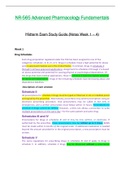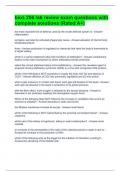NR-565 Advanced Pharmacology Fundamentals Midterm Exam Study Guide (Notes Week 1 – 4) Week 1 Drug Schedules Each drug preparation regulated under the CSA has been assigned to one of five categories: schedule I, II, III, IV, or V. Drugs in schedule I have a high potential for abuse and no approved medical use in the United States . In contrast, drugs in schedules II through V all have approved applications . Assignment to schedules II through V is based on abuse potential and potential for causing physical or psychological dependence. Of the drugs that have medical applications, those in schedule II have the highest potential for abuse and dependence . Drugs in the remaining schedules have decreasing abuse and dependence liabilities. -Descriptions of each schedule Schedule II All prescriptions for schedule II drugs must be typed or filled out in ink or indelible pencil and signed by the prescriber . Alternatively, prescribers may submit prescriptions using an electronic prescribing procedure. Oral prescriptions may be called in but only in emergencies, and a written prescription must follow within 72 hour s. Prescriptions for schedule II drugs cannot be refilled. However, a DEA rule allows a prescriber to write multiple prescriptions on the same day —for the same patient and same drug. Schedules III and IV Prescriptions for drugs in schedules III and IV may be oral, written, or electronic. If authorized by the prescriber, these prescriptions may be refilled up to 5 times . Refills must be made within 6 months of the original order . If additional medication is needed beyond the amount provided for in the original prescription, a new prescription must be written. Schedule V The same regulations for prescribing drugs in schedules III and IV apply to drugs in schedule V. In addition, schedule V drugs may be dispensed without a prescription provided the follow ing conditions are met : (1) the drug is dispensed by a pharmacist; (2) the amount dispensed is very limited; (3) the recipient is at least 18 years old; (4) the pharmacist writes and initials a record indicating the date, the name and amount of the drug, a nd the name and address of the recipient; and (5) state and local laws do not prohibit dispensing schedule V drugs without a prescription . •Examples of drugs in each schedule Schedule I Drugs: Opioids, Acetylmethadol, Heroin, Normethadone, marijuana, any others Schedule II Drugs: Opioids, Alfentanil, Codeine, Fentanyl, Hydrocodone, Methamphetamine, Barbiturates, Cocaine Schedule III Drugs: Opioids, Buprenorphine, Paregoric, Cannabinoids, Dronabinol (THC), Stimulants, Testosterone, Ketamine Schedule IV Drugs: Opioids, Benzodiazepines, Alprazolam, Chlordiazepoxide, Clonazepam, Lorazepam, Midazolam Schedule V Drugs: Opioids, Diphenoxylate plus atropine, Pregabalin •Which ones can and cannot be prescribed by nurse practitioners? -Prescriptive Authority Prescriptive authority is the legal right to prescribe drugs. Full prescriptive authority affords the legal right to prescribe independently and without limitation. There are two components of prescriptive authority: (1) the right to prescribe independently and (2) the right to prescribe without limitation. The provider who prescribes independently is not subject to rules requiring physician supervision or collaboration. Full-practice scope Nurse practitioners have the autonomy to evaluate patients, diagnose, order and interpret tests, initiate and manage treatments and prescribe medications , including controlled substances without physician oversight. Reduced -practice scope Nurse practitione rs are limited in at least one element of practice. The state requires a formal collaborative agreement with an outside health discipline for the nurse practitioner to provide patient care. Restricted practice scope Nurse practitioners are limited in at least one element of practice by requiring supervision, delegation, or team management by an outside health discipline for the nurse practitioner to provide patient care. ▪Understand what prescriptive authority is and who mandates it. Prescriptive authority for nurse practitioners also regulates prescribing rights beyond medications and controlled substances. These rights include therapeutic devices and services and are outlined in state practice laws and regulations a nd include Durable Medical Equipment (DME) such as wheelchairs, power scooters, hospital beds, portable oxygen equipment, handicap placards, etc. and medical services such as Physical Therapy (PT), Occupational Therapy (OT), home health services, etc. Pres criptive authority encompasses more than writing a prescription correctly. It requires adherence to ethical guidelines to ensure that patients are safeguarded from harm. Ethical prescribing starts with being well-informed about medications. Mechanism of action, efficacy, and safety are important considerations, as are a patient's distinct needs and circumstances, including the number of medications prescribed (Mitchell & Oliphant, 2016). Most patients receiving a prescription are taking other medications, whether prescription or over -the-counter. Appropriate selection, dosing, and duration of pharmaceutical agents are key to maximizing outcomes and minimizing adverse effects Prescriptive authority is determined by state law. The regulation of prescriptive authority is under the jurisdiction of a health professional board. This may be the State Board of Nursing, the State Board of Medicine, or the State Board of Pharmacy, as determined by each state. ▪What problems arise when prescriptive authority is limi ted? Limited prescriptive authority creates numerous barriers to quality, affordable, and accessible patient care . For example, restrictions on the distance of the APRN or PA from the physician providing supervision or collaboration may prevent outreach to areas of greatest need. A requirement to obtain the physician's cosignature on prescriptions can increase patien t waits. Despite the use of terms such as collaborative arrangement, these relationships create a situation in which one partner holds the power. In the event of dissolution of the arrangement, the ultimate loss is commonly assumed by the advanced practice provider rather than the physician. •Know the responsibilities of prescribing need route on every prescription. for future reference, if giving a 90 day rx then refills needed = 3 The best way to keep your patients (and yourself) safe is to be prudent a nd deliberate in your decision -making process. Have a documented provider –patient relationship with the person for whom you are prescribing. Do not prescribe medications for family or friends or for yourself . Document a thorough history and physical examination in your records. Include any discussions you have with the patient regarding risk factors, side effects, or therapy options. Have a documented plan regarding drug monitoring or titration, if applicable . If you consult additional providers, note that you did so. •Know patient reasons for medication non -adherence (might need more reasons ) Patient education about treatment regimens increases medication adherence. Education provides an opportunity to address questions and dispel misunderstanding, reducing errors. Medication education should include: • medication name: generic vs. trade name • purpose: the reason for taking the medication, including the desired effect • dosing regimen: how much medication, how often, and the time of day • administration: preparations needed for taking, such as with or without food • adverse effects: all possible risks and how to manage them • special storage needs if needed such as refrigeration or use of the original container • associated laboratory testing, including regular appointments • food or drug interactions: what to avoid and what measures to take • duration of therapy: length of administration All medications require monitoring to achieve a therapeutic ou tcome. If the medication is not creating the desired outcome, it likely will not be continued. Every drug has side effects, requiring ongoing assessment of the ratio of benefits and risk. According to Rosenthal and Burcham, (2021) drug monitoring has three aims: • determining therapeutic dosage • evaluating medication adequacy • Identifying adverse effects •Know how what type of evidence prescribers should use to make treatment recommendations Rational drug selection requires a logical approach that includes the formulation of a diagnosis based on clinical reasoning and the selection and monitoring of





